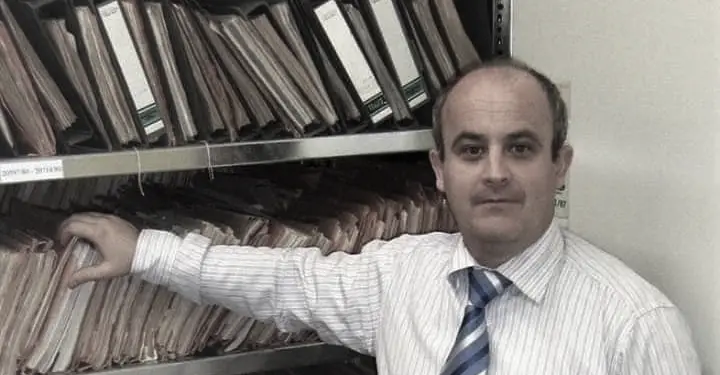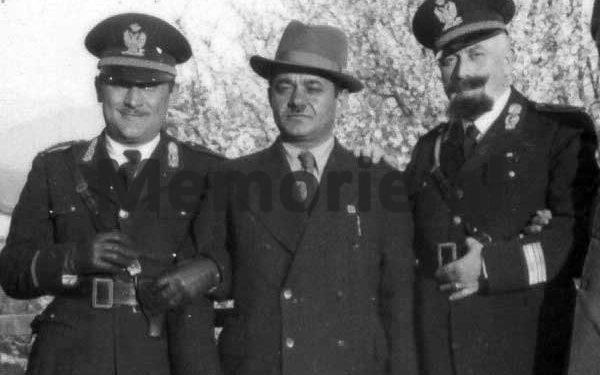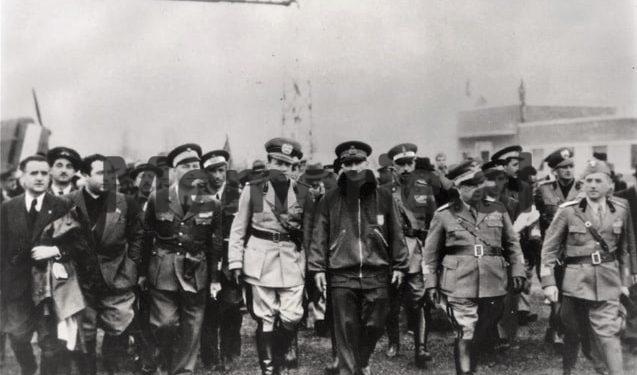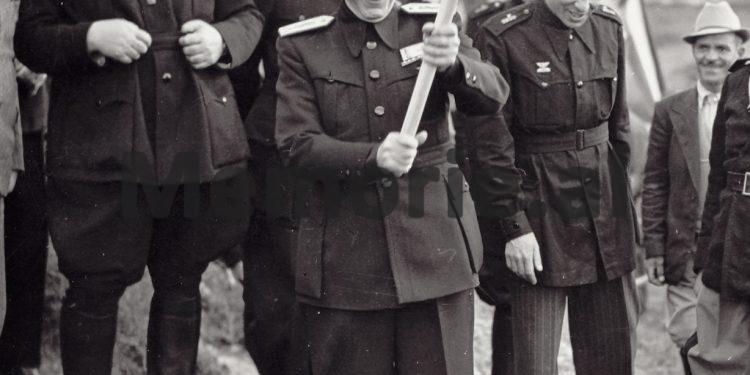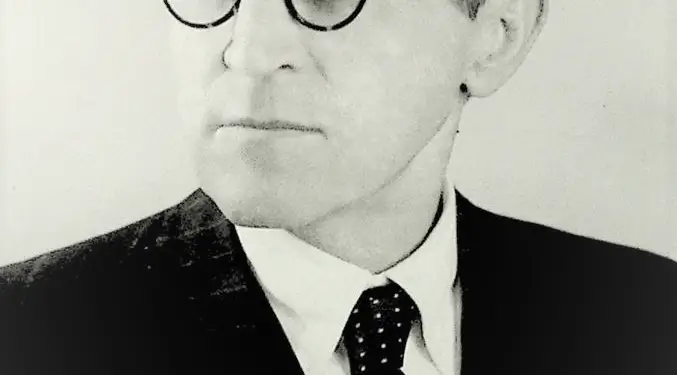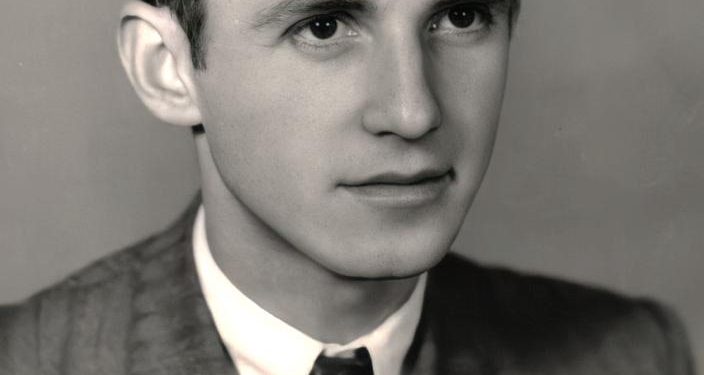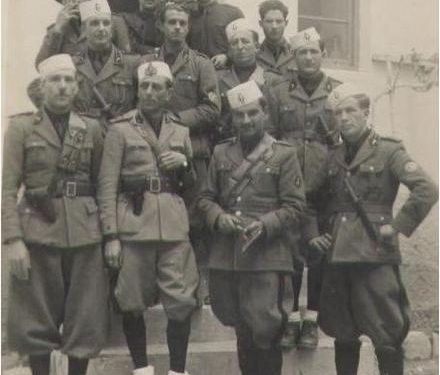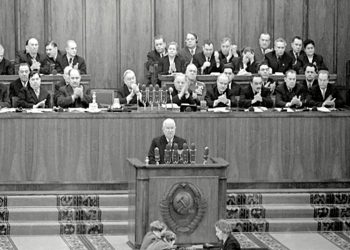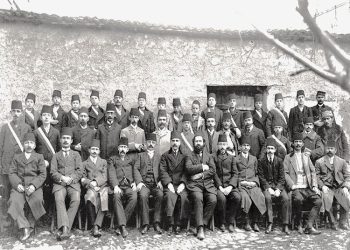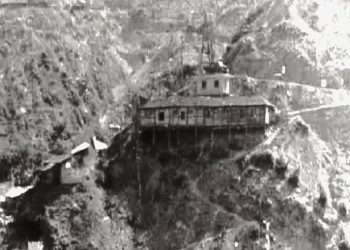By Kastriot Dervishi
– Who were the bases of fascism in Albania, how did the fascist apparatus work and what were its institutions, what was the Statute of the Fascist Party, who were the communists who pretended to be fascists before 1941, was Enver Hoxha a fascist? –
Memorie.al / A taboo topic, unknown and almost untouched in Albanian historiography is the one that has to do with fascist ideology and its spread in Albania in the years 1939-1943. Of course, fascism has been talked about and written quite a bit in a certain sense, but it has never been written about the functioning of its party and state apparatus.
On the other hand, the period in question cannot be left out of the scope of the study only for ideological reasons. Moreover, many later members of the Communist Party of Albania were among the most prominent fascists before the collapse of the German-Soviet pact, which occurred as a result of Germany’s attack on the Soviet Union in June 1941.
What was Mussolini’s fascism?
Benito Mussolini (July 25, 1883 – April 28, 1945) was the inspiration of fascist ideology. The future fascist leader, after spending a difficult childhood, at the beginning of the 20th century became active in several press bodies until in 1912 he managed to run the socialist newspaper “Avanti”. After participating in the First World War in the ranks of the Italian army, Benito Mussolini created on March 23, 1919 in Milan, the first nucleus of the Fascist Party.
Very quickly in the space of three years, his party had a membership of 700 thousand people. Mussolini’s fascism consisted in the great mobilization of moral and material forces. Their organization was a military and trade union along with the political one that consisted of factions, teams and unions. Later, the federations and unions were merged into provincially based federations. The members of the Fascist Party also had their own special uniform, which was the black shirt. For this reason, fascists were also often called black shirts.
On April 21, 1922, Benito Mussolini, on the day of the founding of the city of Rome, held a large meeting in this city that he described as a “fascist party”. On October 16, 1922, during an assembly in Milan, the fascists decided to march on Rome, based on 5 points which were:
1- Mobilization and occupation of public institutions in the main cities of Italy.
2-The concentration of fascist forces in 5 regions of Italy.
3-The ultimatum addressed to the government led by Prime Minister Facta.
4-Entering the ministries and occupying them at any cost……..
5-Building a fascist government and mobilizing military forces in a city in central Italy if point four failed.
In order to realize the above goals on October 24, 1922, Mussolini organized the great meeting in Naples where 40 thousand fascists and 20 thousand workers accompanied their leader’s speech by repeatedly calling “Duche, Duce…” (Which means leader). After the meeting of Naples, the fascist march began, where thousands of armed fascists headed for Rome.
The General Command of the fascist army was based in Perugia and was led by Emilio De Bono, Italo Balbo, Cezare De Vecchi and Michel Biachi. Italian Prime Minister Facta, seeing this situation, asked King Victor Emmanuel III to declare a curfew and suppress the fascist revolution.
The king’s negative response forced the prime minister to resign on October 28, 1922. This very day has gone down in history as “Fascist courage”. On October 30, Mussolini entered Rome and began preparations to form the new government. Until 1925 Mussolini led a coalition government. After this year, the direction of his government was entirely in the hands of him and the Fascist Party. A year later, the creation of parties and organizations was prohibited by law.
The entry into force of the new Statute of the Albanian Kingdom in June 1939
During the years of the Zogista Kingdom, the fascist ideology had not been able to penetrate in the way it was expected, although a considerable investment had been made by the Italians. As whole, fascist ideas were embraced by a small group of intellectuals, who were later involved in the so-called “Delvina Movement” of 1937 and who defended the theory of “Enlightened Dictatorship”.
After the invasion of April 7, 1939, and the so-called “Personal Union” between Albania and Italy, Albania had an ideal ground for the development of fascist ideas. As a function of “personal union”, the Fundamental Statute of the Albanian Kingdom was then created, which was submitted to Viktor Emanuel III for signature by the head of the Albanian delegation, Prime Minister Shefqet Vërlaci on June 3, 1939. This Statute contained the 7 chapters. In the statute, Albania was defined as an independent state, within the framework of the “Personal Union” and was known as King Victor Emmanuel III. According to the statute, the King appointed and dismissed all ministers.
Instead of the parliament, the statute provided for the establishment of the Supreme Fascist Corporate Council (KEFK). The 6th chapter of the statute was dedicated to the “rights and duties of citizens”.
What was the Fascist Militia?
Among the first organizations of the Fascist Party was the Fascist Militia. On September 18, 1939, Jakomoni signed the decree for the creation of this militia, which was part of the Volunteer Militia for National Security. According to the fascists themselves, this militia “guaranteed the developments of the fascist revolution”. The Fascist Militia was organized in one command and distributed in 4 regions and 10 cohorts. The Fascist Militia was an important part of the Fascist Party since; after all, the member of this party was called a volunteer militia.
– Here is a part of the Statute of the Fascist Party
With the decree signed by Viceroy Jakomoni dated June 2, 1939, the Statute of the Albanian Fascist Party entered into force. The main articles of this statute are the following:
“- The Albanian Fascist Party is a voluntary civil militia under the orders of Benito Mussolini, creator of the Duce of Fascism.
– The Fascist Party is the only party in Albania.
– Admission to the PFSH is done through a request or with the fascist lever. The fascist lever consists in the transition from the sons of Albanians to the ranks of the Albanian balilas and small Albanians; from the Albanian balilas in the ranks of the vanguardists, from the vanguardists in the groups of university fascists and fascist youth; from the university fascists and the fascist youth in the PFSH and the Fascist Militia; from the little Albanians in the rows of Albanian girls; from the Albanian girls in the ranks of the fascist girls, from the fascist girls in the Feminist Bands. The Fascist lever is made for every year.
– At the time of admission to the PFSH, the fascist swears and signs the oath formula:
“I swear that I will carry out the orders of the Duke, the Founder of the Empire and the Creator of New Albania – and I will serve the cause of the Fascist Revolution and if necessary with my blood.”
-PFSH consists of bandages. Bands are included in provinces, in Federations of Bands. The frame of the signature in the PFSH of a municipality. Fascist neighborhood groups can be formed between urban centers and important factions. The neighborhood group is entrusted with functions analogous to those of Fashi within the limits of a toxic character set by the secretary of Fashi. The neighborhood fascist group consists of at least two sectors. The sector summarizes two to six nuclei and does not coordinate the activity… The nucleus contains the basic organizational unit of the PFSH and must be formed near each faction, near each agricultural center of the district of each Fashi.
– The organizations of PFSH are:
University fascist groups
a-The Sonship of the Lictor
B-Feminine bandages
C-Two-part opera
– Fascist Assistance Organization
Labor organizations depend directly on the PFSH
– Next to each federation of fascis are formed: a Federal Command of the Lictor’s Office; a group of university fascists; a Federation of Femonal Bandages; a provincial dopolavore; a Provincial Committee of the Fascist Assistance Entity.
– Next to each Entity are formed: A command of the Bands of the Lictor’s Sonship, a Femnuer Band; a dopolavoro; a Municipal Committee of the Fascist Assistance Entity.
– The PFSH hierarchs are:
1-Secretary of PFSH
2-Participants of the Central Directorate
3-Federal secretaries
4-Participants of the Federal Directorate
5-The political secretary of the party
6-Participants of the Fashi directorate
7-Fiduciary of the Fascist Group of the neighborhood
8-Participants of the Neighborhood Fascist Group Consultation
9-The head of the sector
10-Chairman of Nucleo
– The collegial bodies of the PFSH are:
1-Central Directorate
2-Central Council
3-Directorate of the Band Federation
4-Directorate of Fashi
5-Consultation of the Fascist Group of the neighborhood
(Taken with abbreviations from the Official Journal no. 39, dated June 9, 1939, appendix)
Fascist organization, Prime Minister Shefqet Vërlaci’s son, Ismaili, gives his example
The complete organization of the Albanian Fascist Party ended after almost a year. This is because only in 1940 was the structuring of the PFSH completed and the formation of the appointed legislative body, which was the Supreme Corporate Fascist Council (KEFK). The Fascist Chamber was the highest organ of the party and consisted of:
-Members of the Council of Ministers
-Participants of the Central Directorate of PKFSH
-Federal secretaries
-Federal inspectors
-Productive and intellectual activities
(Source of information: “Tomori” newspaper, April 3, 1940)
The Fascist Chamber was inaugurated in Tirana on April 17, 1940 with a special ceremony held in the former parliament hall (today the puppet theater).
The leader of the Fascist Party was necessarily a member of the Council of Ministers. And this innovation in Albanian politics started with the first president of the PFSH, Tefik Mborja and continued in all other Albanian governments until September 10, 1943.
When the Fascist Party had entered its most important phase, on June 11, 1940, the son of Prime Minister Shefqet Vërlaci, the student Ismail Vërlaci, before the last exam asked to be mobilized as a volunteer in a unit of the Albanian Fascist Militia. The second fascist battalion that would leave Elbasan on June 14, 1940 (“Tomori” newspaper, June 12, 1940).
What was the Supreme Corporate Fascist Council (KEFK)?
Although it had been a year since the law for the creation of the Corporate Fascist Supreme Council had been issued, its constitution had not been made due to the incomplete completion of the structuring of the Fascist Party. The Fascist Supreme Council was an appointed legislative body, composed of members of the PFSH. The attributes of its operation came out with decree no. 101 signed by Françisko Jakomoni (see “Official Gazette” no. 52 dated April 4, 1940).
KEFK included:
1-The members of the Central Council of the Fascist Party, at the time of the constitution of KEFK, were Tefik Mborja, Piero Parini, Col. Bib Mirakaj, Kosta Kote, Vangjel Koça, Qazim Neki, Nush Bushati, Sabaudin Toto, Muhtar Vrioni, Germano Secreti , Fausto Cinjolino.
2-Members of the Central Directorate of the PFSH (consisting of 20 people).
3-Members of the Central Council of Corporate Economy (where 29 other people participated in addition to the ministers).
With a special decree of Jakomon, Terenc Toçi was appointed chairman of KEFK, while vice-chairmen: Emin Toro and Nush Bushati.
Among the main tasks of KEFK was the approval of various laws
What was the Council of State?
The body of the State Council continued to function even during fascism. His task was the same as it had been at the time of the Zogist Kingdom and had to do with the preparation of codes or draft laws. To be emphasized is the fact that the first President of the communist state, Omer Nishani, also participated in this council during the time of fascism. Other well-known names were those of Spiro Koleka, Riza Dani, etc. The State Council consisted of 39 members and most of them had been determined opponents of Ahmet Zogu in exile.
Fascists who converted to communists…!
It is already a known fact that many later members of the Communist Party were among the most active fascists of the time. Especially a part of the communist wing of the so-called “Revolution of June 1924”, embraced the fascist ideology quite quickly, due to the very fact that the fascist party was built like the communist one from a schematic and organizational point of view.
From April 1939 to June 1941, many members of communist groups or their sympathizers were members of the Albanian Fascist Party. Among the most popular names was Omer Nishani. In the first years of fascism, he was a member of the State Council. Dr. Nishani was also active in the fascist press, where he praised the fascist doctrine.
This fact did not escape even the foreigners that when the Albanian government delegation was in Paris at the Peace Conference on August 21, 1946, after the speech of Prime Minister Enver Hoxha, the Greek delegate Caldaris quoted an article by Omer Nishan in favor of fascism, published a few years ago formerly in the fascist press.
Nishan’s existence in the State Council is also mentioned by Enver Hoxha in his book “When the foundations of the new Albania were laid”.
Ramiz Alia, Kahreman Ylli, Qazim Kondi, etc. are also mentioned among the most famous fascists who became staunch communists. The fascist press also wrote names such as: Aleksandër Xhuvani, (see “Tomori” newspaper, dated June 20, 1942), Anton Mazreku (sports chronicles), Haki Stërmilli, Muzafer Xhaxhi, etc. None of these had any consequences, while it should be remembered that the director of the “Tomori” newspaper was shot after the war at the age of 33.
Undoubtedly, Ramiz Alia is among the most interesting fascists of this time. At the time he completed high school (in the place where the Chamber of Commerce in Tirana is today), he was among the most active members of the Fascist Youth.
It also appears from the documents that Fatos Nano’s mother, Maria Shuteriqi, was among the most well-known fascists in Elbasan. The deceased is included in the list of Fascist Women of Elbasan, a list that was published in the newspaper “Tomori” dated July 19, 1940, page 2 in the article “Expectation of the Black Shirts in Elbasan”.
According to witnesses who live in Elbasan, the late Shuteriqi was among the most active in fascist life in Elbasan, both in Dopolavore’s houses in the “Kala” neighborhood and in the city bazaar, or in other political activities.
Generally after June 1941, we have the big transition from fascist to communist conversion. Ironically, the fascists in the party addressed each other with the word “comrade”. Albanian socialists do the same thing today.
Was Enver Hoxha a fascist…?
There are data that leave no doubt that even the communist leader Enver Hoxha was a fascist. To reinforce such an argument, there is a photograph taken at the beginning of 1941 in the house of Mustafa Kruja in Krujë, where, in addition to him, Enver Hoxha, Xhovani Xhiro (the main person who dealt with the spread of fascist ideology in Albania) is also seen. , Nikola Kotte, Kostandin Kotte and Aristidh Lamani. All the people posed in front of an overflowing table.
This photograph took place for many years in the house of the aforementioned person and it is enough to say that even Enver Hoxha did not fall out of sympathy for fascism. Of course, he was part of the fascists who would convert to communists and who would then turn “anti-fascism” into a strong tool of their existence to justify the terrorism they often practiced.
Conclusion
The theory of “anti-fascism” has never been present among the left forces even in the years of political pluralism in Albania. For the sake of truth, the communist forces have never had any significant persecution by the fascist regime of the time. This is also because many of the communists knew the functioning of the fascist apparatus quite well. What should be emphasized is the fact that the communist ideology has been for the Albanian nation many times more pronounced and destructive for the Albanian nation, without having any sign of liberalism.
Above all, in Albania, communism was Slavic-communism. However, in both political extremes, all the qualities can be easily extracted. But today in the 21st century, it is not at all lazy to paint the walls with tiles with red stars in search of preserving a glory that never existed. These very signs that keep communist ideology alive are more dangerous than one might think. /Memorie.al





